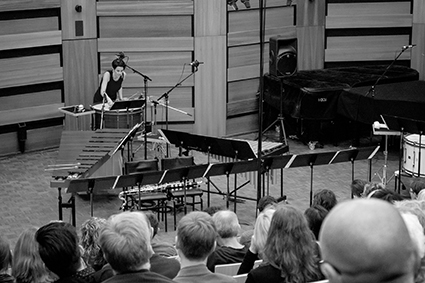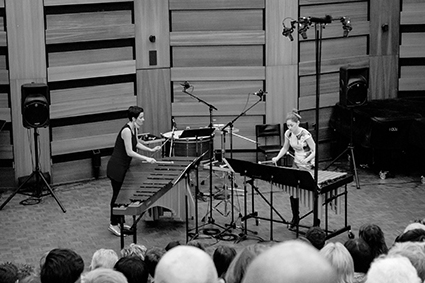Adventures in timbre and texture
Alex Turley: Totally Huge New Music Festival: Time Alone

Time Alone
photo Holly Jade
Time Alone
The Totally Huge New Music Festival in Perth was brought to a stunning conclusion with Time Alone, a program of percussion and clarinet music infused with electronics. Visiting artist Claire Edwardes brought a vibrant enthusiasm to the stage, guiding the audience through a program that she clearly loved. She was joined by Perth based percussionist Louise Devenish and clarinetist Ashley Smith, both in fine form.
Chris Tonkin’s IN provided a vivid exploration of the sonic possibilities of a bass drum excited by different materials and processed through electronics. Edwardes coaxed ethereal drones, squeals and shrieks from the drum using a variety of mallets, fingers, bouncy balls and at one point a scrubbing brush. Tonkin’s electronics interacted with and warped the sound, not overpowering it but complementing Edwardes’ gestures. Ghostly fragments of speech speckled the work’s texture. IN is never boring, constantly turning corners into new and unfamiliar sonic territory.
Ashley Smith takes the foreground to perform Magnus Lindberg’s decibel-pushing Ablauf, a work that prompts the elderly woman in front of me to immediately put in earplugs. Smith’s performance is very present and gripping as he interprets the multiphonics, screams and shouts with gusto. Edwardes and Devenish, each at a bass drum on opposite sides of the stage, interrupt with gestures that gradually break away from one another. Put simply, the overarching shape is a decrescendo, and though the piece comes to a soft end, tension and atmosphere are sustained throughout.
Damien Ricketson’s Time Alone is a beautiful solo for vibraphone and electronics. Edwardes performs lonely, meandering melody while subtly manipulating the vibraphone’s motor to affect reverberation. The electronics are hushed at first but begin to bring out and play with the resonance of the vibraphone. What begins as an introverted hum develops later into foreign morse-code-like rhythms, drawing us down into what feels like an underwater texture. For all its simplicity this piece had a powerful effect, shimmering and glistening with a certain timelessness.

Time Alone
photo Holly Jade
Time Alone
“There’s a reason why people use sticks on a marimba,” says Edwardes as she and Devenish prepare for Michael Smetanin’s Finger Funk. They play with fingers only (though their thumbs are reinforced by erasers to protect against pain). The result is a ghostly and insect-like timbre. I wouldn’t expect such a specific, soft textural effect to be sustained for an entire piece, but Edwardes and Devenish manage to coax vastly different sounds from different dynamic effects and utilise the entire range of the instrument with sweeping glissandi.
Smith took the reins once more to perform Nico Muhly’s It Goes Without Saying for clarinet and electronic backing. The prerecorded electronic part explores an aggregated clarinet sound, playing with a texture that feels like it breathes heavily. Smith’s part weaves in and out of focus with fluid lines that contrast against Muhly’s agitated backing texture. His playing is elegant and refined but perhaps more valuable than the piece warrants.
The program is brought to a close by a stunning rendition of Ligeti’s Continuum, a direct transcription for vibraphone and marimba from the original harpsichord part. The earthy harmonic sound of the marimba works well with the sparkly vibraphone wash to create a spiraling cloud of sound. The piece is exciting and visually striking, a perfect end to this years Totally Huge festival.






